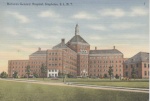Difference between revisions of "Portal:Featured Article Of The Week"
M-Explorer (talk | contribs) |
M-Explorer (talk | contribs) |
||
| Line 1: | Line 1: | ||
{{FAformat | {{FAformat | ||
| − | |Title= | + | |Title= Willowbrook State School |
| − | |Image= | + | |Image= 1980_20b.jpg |
|Width= 150px | |Width= 150px | ||
| − | |Body= In | + | |Body= In 1938, plans were formulated to build a facility for mentally retarded children on a 375 acres (1.5 km²) site in the Willowbrook section of the Staten Island. Construction was completed in 1942, but instead of opening for its original purpose, it was converted into a United States Army hospital and named Halloran General Hospital, after the late Colonel Paul Stacey Halloran. After the war, proposals were introduced to turn the site over to the Veterans Administration, but in October, 1947 the New York State Department of Mental Hygiene opened its facility there as originally planned, and the institution was named Willowbrook State School. |
| − | + | Throughout the first decade of its operation, outbreaks of hepatitis were common at the school. This led to a highly controversial medical study being conducted there between 1963 and 1966, in which healthy children were intentionally injected with the virus that causes the disease. These studies were designed to gain an understanding of the natural history of infectious hepatitis and subsequently to test the effects of gamma globulin in preventing or combating the disease. | |
| − | The | + | The subjects, all children, were deliberately infected with the hepatitis virus; early subjects were fed extracts of stools from infected individuals and later subjects received injections of more purified virus preparations. Investigators defended the deliberate injection of these children by pointing out that the vast majority of them acquired the infection anyway while at Willowbrook, and perhaps it would be better for them to be infected under carefully controlled research conditions. [[SWillowbrook State School|Click here for more...]] |
}} | }} | ||
Revision as of 02:50, 14 March 2016
Featured Article Of The Week
Willowbrook State School
In 1938, plans were formulated to build a facility for mentally retarded children on a 375 acres (1.5 km²) site in the Willowbrook section of the Staten Island. Construction was completed in 1942, but instead of opening for its original purpose, it was converted into a United States Army hospital and named Halloran General Hospital, after the late Colonel Paul Stacey Halloran. After the war, proposals were introduced to turn the site over to the Veterans Administration, but in October, 1947 the New York State Department of Mental Hygiene opened its facility there as originally planned, and the institution was named Willowbrook State School.
Throughout the first decade of its operation, outbreaks of hepatitis were common at the school. This led to a highly controversial medical study being conducted there between 1963 and 1966, in which healthy children were intentionally injected with the virus that causes the disease. These studies were designed to gain an understanding of the natural history of infectious hepatitis and subsequently to test the effects of gamma globulin in preventing or combating the disease.
The subjects, all children, were deliberately infected with the hepatitis virus; early subjects were fed extracts of stools from infected individuals and later subjects received injections of more purified virus preparations. Investigators defended the deliberate injection of these children by pointing out that the vast majority of them acquired the infection anyway while at Willowbrook, and perhaps it would be better for them to be infected under carefully controlled research conditions. Click here for more...
